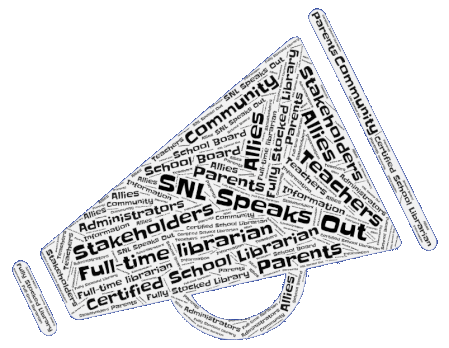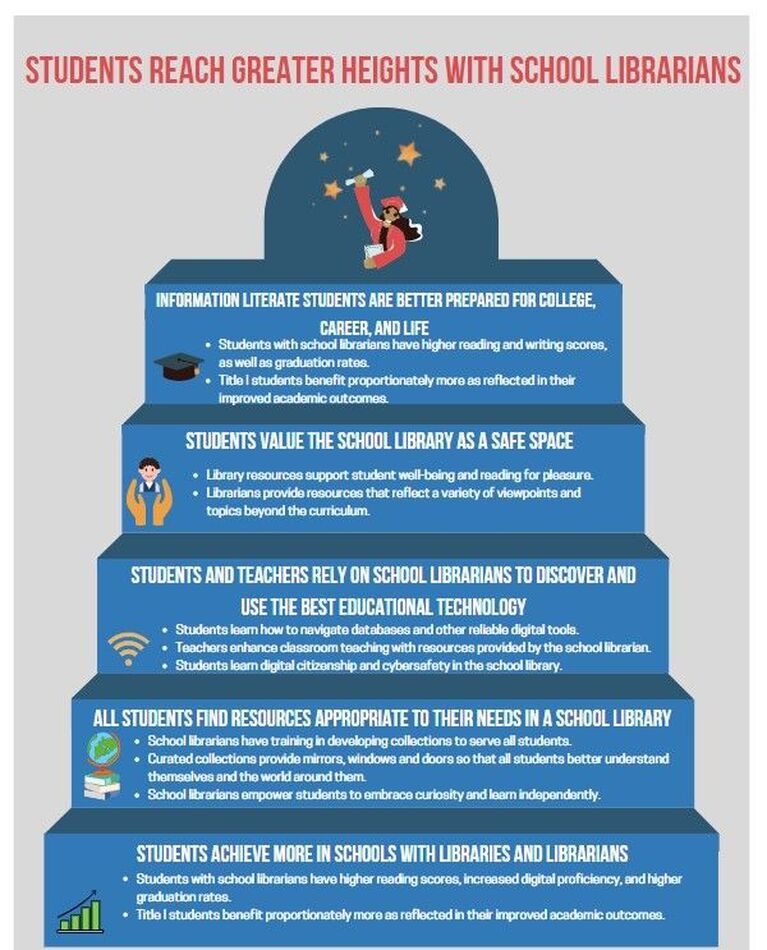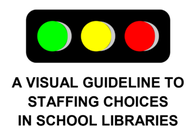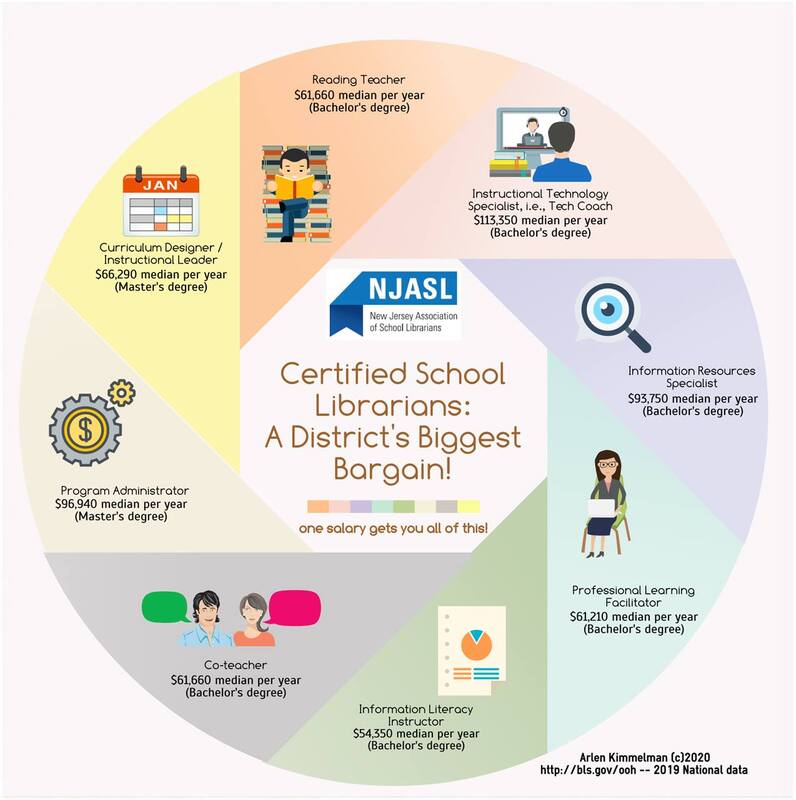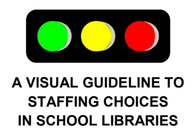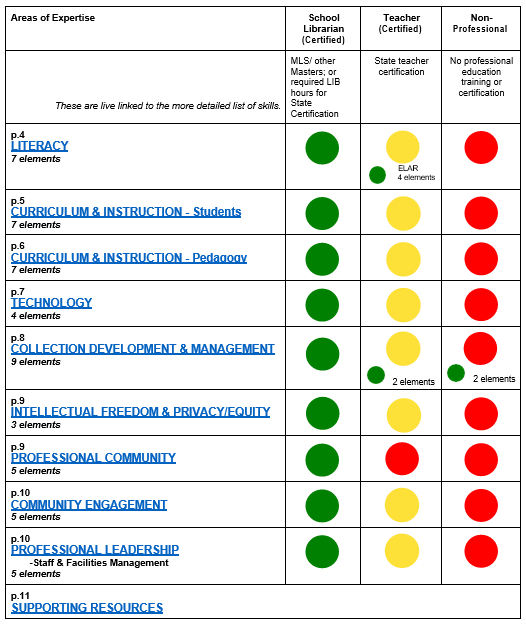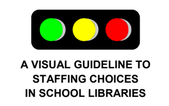|
by Dorcas Hand The Committee on Library Advocacy of the American Library Association published this infographic recently to illustrate the benefits to every K-12 student of open access to a fully funded and fully staffed school library. Students Need Libraries in HISD offers the image to support all the advocates across HISD who are speaking up for equity of access to school libraries for all HISD students. Sadly, it is those neighborhoods with the most challenges that are least likely to have a fully funded school library staffed by a certified school librarian. We are working together to convince Superintendent House, his staff and all the campus administrators across the district to step up for school libraries on behalf of our students and in support of stronger literacy achievement.
The image above is the front page. The back page includes supporting documentation for each point, as illustrated by these examples.
Parents, parent organizations, teachers, and community advocates need to speak out often about the fact that HISD has only about 55 certified librarians for 280 schools. Another 75 or so have certified teachers staffing the library. That leaves approximately 140 schools with either non-certified staff (50) or a closed library. We can do better. Please share this information with your campus community to be sure they speak up frequently. Start with the campus principal who currently makes that decision - but don’t forget the district, because both the Superintendent’s office and the School Board need to know what benefits students miss out on when not served by a library adequately staffed and stocked with up-to-date, compelling materials.
0 Comments
CAMPUS LIBRARIES
CLASSROOM LIBRARIES
ARTICLES about School Libraries with Certified School Librarians
by Dorcas Hand Certified School Librarians in Texas are certified teachers with at least two years full-time classroom teaching experience PLUS coursework in library science PLUS a Masters Degree. https://www.ischool.utexas.edu/programs/school-librarian-certificate/requirements-notices In Houston ISD, personnel with all this additional training are paid the same as any classroom teacher making the expertise held by the campus librarian a bargain!
HISD has just hired a new Superintendent. We at Students Need Libraries in HISD welcome Millard House. He comes from Clarksville-Montgomery County School Systems in Tennessee, where every school has a certified librarian. Consequently, we have high expectations that he will work to offer students across HISD the EQUITY of a school library that is fully funded, holds a diverse collection of materials appropriate to the student population, and is staffed full-time by a certified librarian. HISD Library Services stands at the ready to support him in making this change.
YOU who read this blog post hold the responsibility as members of the Houston ISD community to speak out for equity for all our students. HISD Literacy rates are much lower than they should be, and inconsistent across the district in part because students have not had reliable access to school libraries that support the students’ own reading interests with awareness of their skill levels and abilities. Together, we can change what has been into what can be. Mr. House,
Welcome to HISD. We represent a grassroots group of community members, parents, and other advocates who want to see a dynamic library in every school. We have a website (Students Need Libraries in HISD) that provides information about HISD libraries in particular and school libraries in general. As a new Superintendent, here’s what you need to about HISD libraries: (1) Numbers: As of mid-July, there are only 55 certified librarians in a school district of over 280 schools. Too many schools have no library at all, but most schools have clerks or teachers assigned to manage the library. Although these individuals have been trained to circulate books, most of those assigned to the library cannot provide the instructional services (book selection, teaching research skills, etc.) required. The perception among those who might apply is that a library position in HISD is insecure. We have lost many good librarians to other school districts as a result. Five out of the ten librarians who were selected as Librarian of the Year in the past decade have left the district to work as a librarian in outlying districts. Here is the link to library staffing data in recent years: http://www.studentsneedlibrariesinhisd.org/library-staffing-overview.html (2) Site-based Management: Principals have the final determination as to whether the library is open or closed and whether to hire a librarian, a teacher or a clerk to staff the library. In general, many principals are not aware of the benefits of a strong library program and do not realize the librarian’s impact on student achievement for all students. When principals attend the district’s budgeting sessions, they are likely to be told they cannot afford a librarian. (3) Board Policy: Reading the board policies, the district clearly has a commitment to providing library services to all students. The problem is that these policies are not being enforced or considered when staffing libraries or making decisions that affect students’ access to libraries. (4) Department of Library Services: This department is the district’s expert on staff in the management of existing libraries and the design of new libraries. For many years, HISD Library Services was part of the School Support team which was a good fit for this department as libraries provide ongoing academic support to both students and teachers. For the past ten years, Library Services has been under the Curriculum department which has not been a good fit. Currently, the department is under the purview of Elementary Curriculum, ignoring the fact that libraries serve schools PreK-12. Under Curriculum department management, there have been numerous cutbacks in staffing and budget. (5) Equity: Ultimately, the strongest argument for the restoration of the library program in HISD is equity. There are some communities in HISD which have never failed to staff their libraries. There are too many communities - whole feeder patterns - where the books on the library shelves have disappeared or the collections have been allowed to stagnate locked in time. A return to centralized budgeting for all libraries would benefit student success. Conclusion: School libraries and certified librarians offer a strong toolkit to support improved literacy scores across the district. Investment in libraries is a long-term effort with benefits for all HISD students in test scores and graduation rates. The ESSER funds already requested by Library Services offer a huge opportunity to rebuild the campus library collections and develop plans to support increased staffing over a few years. We look forward to seeing what your new leadership will bring to HISD. We know that your libraries in Clarksville-Montgomery were all fully staffed with certified librarians. We urge you to take this opportunity to recommit to the idea that all HISD schools have access to library programs as well. You have our support in this effort. Sincerely, Dorcas Hand Debbie Hall Library Advocate/ volunteer Houston, Texas http://www.studentsneedlibrariesinhisd.org/ Eliminating school libraries and librarians deprive students of diverse and equitable opportunities to learn the essential college and career skills necessary to be successful.
Campus Libraries
Classroom Libraries
ARTICLES about School Libraries with Certified School Librarians
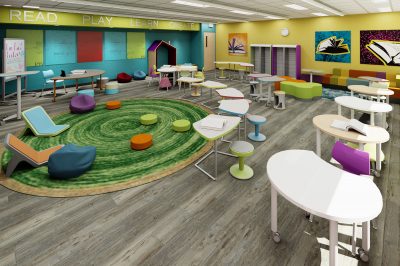 A sample design from the DEMCO website that reflects instructional space, relaxed seating, display space and shelving. This is not the "best" option - it merely illustrates the multifaceted nature of school library spaces. A sample design from the DEMCO website that reflects instructional space, relaxed seating, display space and shelving. This is not the "best" option - it merely illustrates the multifaceted nature of school library spaces. By Debbie Hall We sent the letter below to the HISD Building Dept. today in response to our increasing awareness of problematic library designs in new and renovated HISD campuses. Everyone should speak up when they see these issues, to campus admin, parents and school board representatives. I am a former HISD librarian and a current advocate for HISD and particularly the district’s library program. I have seen the impact that libraries can have on the lives of our students and presently I am very concerned with the direction HISD is going in regards to designing new library spaces for students. At a time when we know that literacy rates are declining, HISD should be following best practices in school library design and being more strategic when planning library spaces for its students. From the results, I am seeing in new buildings and even in renovations, I cannot understand what the current HISD library design guidelines are or if there are any guidelines. I see spaces that restrict the types of interactions available between the student, the teacher, and the librarian. I see libraries without walls, libraries in hallways, and libraries with no identifiable space at all. I see some new schools being built without a library. The current designs may look good on paper but I seriously question how these spaces will function serving the needs of students and teachers both now and in the future. Libraries are for learning and instruction. The most obvious flaw with HISD's current school library design is that large group teaching space has been eliminated in some cases. The effect of this lack of instructional space is that the library becomes a space for only small group or one-on-one interactions. Schools with this type of floor plan cannot support the instructional mission of the library. Too many of the new HISD "libraries" are merely shelves with books in an open unsecured area, often a hallway. Guidelines for library design address multiple activities. In a school library, there should be a space for large group instruction, comfortable reading areas, viewing areas, study carrels, shelves, computers, tables to write or design, maker spaces, and areas for quiet reflection/thinking. Where would a librarian introduce research skills to a large class or small group in a library without an area dedicated to instruction? If the elementary library is in a hallway, how can a story be read aloud to engage readers? What about security? The library collection is typically one of a school's most valuable assets. If there are no walls and no way to restrict access, how is the inventory of its contents kept safe for all to use? Does the fact that Lamar High School has placed library books and shelves in a hallway - without a librarian even - make that space a library? The following schools were recently built with two-story open-concept library designs: Condit, Braeburn, Kolter and Scarborough. The open-concept plan was very popular in 1965 and it was largely a failure. The idea is being resurrected. While you can find positive and negative reviews of this model, I think most librarians would find it very challenging to manage students where they can be spread over two floors. The acoustic issues, including student distraction and strain on teacher voices not to mention discipline issues when students are out of sight on a different floor, have been common complaints in many such designs. I have talked to several librarians who shared their experiences serving on their building committee to plan new HISD schools. All of them expressed frustration about getting their concerns answered. Most recently I have spoken to the former librarians at HSPVA, Bellaire, and HSHP who expressed their dissatisfaction with the process. They were able to get some but not all of the changes that they felt were needed to make the spaces work for their students and staff. The schools that do not have a librarian on staff have no one speaking up for a functional library design in a new facility. This is especially problematic if the principal has no idea what a good 21st-century library should look like. The district’s office of Library Services should take part in all meetings where important decisions about the library design are made. In any large school district, the Department of Library Services is tasked with providing expertise on what school library programs should offer and how library spaces should look and function. Until recently, all HISD school library designs were a result of a collaboration between the Library Services Department, the school librarian, and the school building committee. I hope that HISD will reconsider this aspect of the building program and once again return to the idea that the library is an instructional hub for the campus. Having bookshelves in the hallway is not the same as providing a library; books in the hallway without a trained librarian is a waste of money. Don’t waste taxpayer’s money, build libraries that are based on design guidelines that take into account the library's mission of connecting readers to books and information. Use the experts on your staff (certified school librarians and the Department of Library Services) to create world-class library spaces. Debbie Hall Library Advocate/ volunteer Houston, Texas by Debbie Hall
In the late 50’s and 60’s, school libraries staffed with certified librarians were found only in HISD’s secondary schools. The Director of Library Services, Elenora Alexander, proposed that elementary schools also needed library services and consequently a plan was made to add libraries across the district. Staffed libraries providing needed services to staff and students was the norm for over forty years across the district. In the past 10-15 years, this standard has deteriorated, and new schools at all levels are being built without any library. Currently only approximately 63 librarians serve in libraries in the 276 schools within the district. A larger number of schools staff their libraries with teachers or clerks. In the Fall of 2020, we have identified 85 schools that are not providing library services due to vacancies or simply not having a library. That number represents 31% of the district’s schools who offer no library program to their students or support to their staff. This brings us to these questions about the current state of school libraries:
Here is what the HISD policy manual (https://pol.tasb.org/Policy/Search/592?filter=library ) states regarding libraries: The Superintendent or designee shall develop rules, regulations, and procedures to ensure the systematic maintenance of libraries as current resources for teachers and students. Principals shall ensure the effective use of the libraries within schools and shall establish library hours, staffing, and procedures that best serve the needs of the students. (EFB Local 2012) Library media centers for each school shall be equipped with resources for reading, viewing, and listening to enhance the regular instructional program and shall be staffed with certified learning resources specialists in accordance with approved staffing guidelines. (EFB Local 2012) Adequate funding for library media programs shall be made through the annual budget. Funds for the purchase of library materials shall be allocated on an equitable basis to the various schools. (EFB Local 2012) The reading of HISD policy clearly demonstrates that the Superintendent and Principals have failed to provide the leadership in maintaining libraries as outlined by district policy. They need to be held accountable for failing to provide the resources that all students deserve. This is an equity issue: every HISD student deserves access to a fully funded library staffed by a certified librarian. by Dorcas Hand
HISD administration is working to decide how to spend the ARP/ESSER funds. That’s the federal American Rescue Plan Elementary and Secondary School Emergency Relief Fund, more than $800 million coming directly to Houston ISD. During the week of May 17-21, a survey was open to the public on how that money should be spent. It is a three-year windfall, which means the district needs to spend it in ways that have staying power. The survey, linked here in PDF, covered lots of potential topics - including Library Services. Yes, Library Services were directly listed. And SNL Speaks Out readers know that we consistently push the idea that school libraries improve student success at school, and we know that libraries do not exist on every HISD campus. How might libraries help in many areas the survey addresses? What are useful ways to invest this one time funding in HISD libraries? Besides libraries, the survey includes
Now, let’s consider areas that library services can impact positively.
CONCLUSION HISD currently has 62 libraries staffed with certified librarians. It is unclear what budget those librarians have for library materials, but all funding is campus based. Yes, there are another 79 libraries staffed by teachers - again with uncertain budgets. There are 274 HISD schools served by Library Services but only 141 (62+79) have library services staffed by trained personnel; 48 have clerks; 43 are vacant; and 41 have no library at all [All data from the same link]. Given that school libraries could positively impact almost all the categories addressed by the HISD Survey, HISD should invest in its libraries so that more campuses have the advantage of library services. How might the district leverage this one time funding to phase in libraries for every student?
by Debbie Hall Currently a Rice group (HERC) is focused on improving outcomes and providing equitable educational opportunities for students in the Houston area and beyond. According to the HISD website:
“The purpose of the Equity Project, conducted in collaboration with partners at the Houston Education Research Consortium (HERC), is to identify the mechanisms through which HISD and the broader Houston community can work to improve equity and ultimately eliminate gaps in achievement and attainment. Information from these studies will help guide district decision-making to improve equity for all HISD students.” If you would like to know more about this research or would like to comment, please follow this link (https://www.houstonisd.org/equityproject) which describes the Equity Project in more detail. One interesting feature of the website is a searchable Needs Map which reveals specific data about school communities like food insecurity, employment, and safety. We ultimately would like to see school libraries in all schools as a recommendation from this project. We keep asking why would libraries be viewed as necessary in some schools but not others. We do see the problem of a lack of library service as being more prevalent in less affluent areas of the district. The following content is what we shared in March with the HERC/HISD project leadership regarding equity: Members of SNL have long been concerned about the growing inequity in Houston schools. There are most definitely haves and have-nots and areas of poverty where needed resources are lacking. Your[HERC] wraparound services assessment clearly speaks to those needs. We speak specifically to the need for library services in all HISD schools and work to broaden awareness of the importance of libraries in schools. Significant research has proven over the years that libraries impact student achievement. You may wish to refer to these two articles from 2018 as more recent examples:
We work with other school library advocacy groups in the US and in other countries. Many members of our group in Houston have worked in HISD schools as volunteers or teachers or librarians. Many of us have had children in Houston schools and thus have first-hand experience with libraries across the district. We advocate for school libraries because we believe that all students need access to a library to learn and grow. We have seen in the last 70 years the rise and fall of school libraries in HISD. In the 1950s, the first district library supervisor, Elenora Alexander, created a plan for providing a school library on all campuses. At that time only secondary schools offered a library for their students. By the late 1960s, her goal was reached with almost all campuses offering library services. All libraries were staffed and had a centralized budget to provide needed library materials for most of these years. This was the norm for over 25 years until the state instituted the site- based decision-making policy in 1992. HISD had no local policy to protect students' rights to access to a school library, therefore principals and SBDM committees were freed to use the money that had supported staffing and library books in other ways. At the same time, schools across the state began to see less financial support from the state legislatures. The STAAR test instituted in 2007 added to the financial deficits of schools as schools used limited resources to pay tutors and provide test prep materials for this high-stakes test. All the above has contributed to the loss of library services across the district. Every fall, we look at the district library directory to see if we have lost or gained library staffing in HISD schools. While the decline in school libraries across HISD has been happening for much longer, we have been monitoring in detail a steady decline in services for the past three years. Our Library Staffing Overview web page provides the data. We see disturbing trends in HISD. Less than 50% of high schools provide access to libraries. The number of libraries listed as vacancies or No Library increases each year. The number of libraries staffed by certified librarians is shrinking. Teachers and clerks are placed in charge of libraries on many campuses. Small charter/magnet schools are often created without a library. New schools are being built without a library, sometimes replacing a school that formerly had a library. We see schools that have closed their libraries and allowed the books to gather dust while other schools have repurposed the library space and dispersed the books, moved them to classrooms, or disposed of them. HISD has lost sight of the importance of school libraries. Neighboring school districts like Alief, Fort Bend, Aldine, and Katy have continued to provide library services to their students. Why is HISD unable to maintain access to the resources a library provides when other neighboring school districts continue to ensure access? Doing away with libraries is the antithesis of a college- bound culture and impacts students in areas without bookstores and access to broad-band networks more severely than more affluent populations. We believe in a library open for students' use is essential to their success. This is where students follow their own learning plan and begin the process of learning to do research and use various technologies. This is where students can dream, explore, and learn about the world. And, as the Pennsylvania Study and numerous other studies have illustrated, students with access to school libraries have stronger test scores. The Pennsylvania study specifically addresses the benefits of school libraries to students who are Economically Disadvantaged, Black, Hispanic, and have IEPs (i.e., students with disabilities). The study findings demonstrate that these students benefit proportionally more than students generally when their schools have full-time librarians. We know that you are collecting data in order to create more opportunities for the children of our city and we applaud that effort. Perhaps we can help you. We hope you are considering libraries as part of the solution when looking at equity and opportunity. It is one of the keys to unlock the equity issue. It remains important that the HISD community speaks out about the need for equitable school libraries across the district, and especially to raise the issue in the superintendent search process and as the new superintendent begins to work with HISD schools. Our HISD principals need to learn that money spent for libraries and librarians is a cost-effective support of literacy efforts for all students and classrooms. by Dorcas Hand
I updated the SNL website this week with some new resources. A new page entitled: "Jan. 6 2021 in Washington DC: Protest or Insurrection? Talking to students about politics, civic engagement, and uncertainty." I will update this as I find more excellent resources. A new page of LatinX resources for students. Two booklists:
I also note some Twitter threads that focus on diverse authorship (#ownvoice(s), #ownvoicesbooks, #hereweeread) and more nuanced explorations of literacy (#disrupttexts). Some work in Instagram as well. #DisruptTexts is also a website. Two new video resources:
And one curriculum resource for high school: Teach the Black Freedom Struggle Campaign. Zinn Education Project. “The Teach the Black Freedom Struggle campaign of the Zinn Education Project (coordinated by Rethinking Schools and Teaching for Change) supports teachers with free lessons for teaching about racism and anti-racist struggles, distribution to school districts of the book Teaching for Black Lives, teacher study groups, a podcast, online classes for teachers, and more.” And here are a few books for adults and teachers about recognizing our biases and finding ways to engage with the world with more awareness of the challenges of stereotypes and biases.
|
AuthorThis blog is primarily authored by Debbie Hall and Dorcas Hand, but guest authors are welcome. If you have an idea to share, please contact our email below. Debbie is a retired HISD librarian and Library Services Specialist. Dorcas is a retired school librarian who remains active in AASL/ALA. Both support increased equity in school library access and support for all HISD students and campuses. Archives
November 2023
CategoriesClick to our Facebook page.
|
